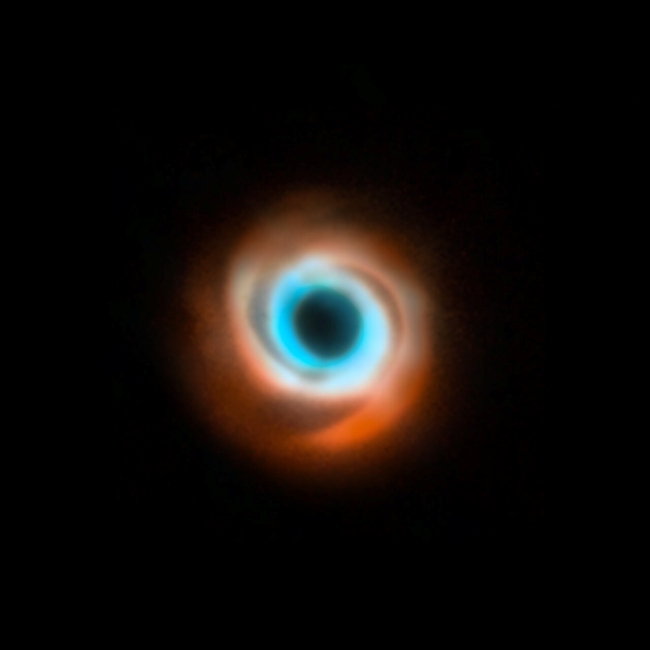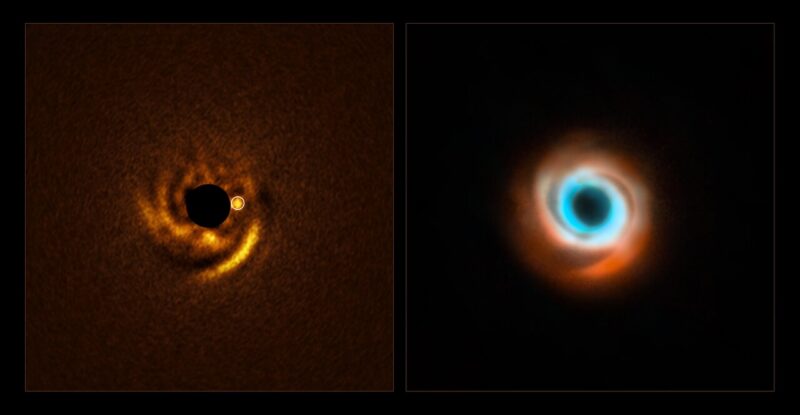ESO published this original story on July 21, 2025. Edits by EarthSky
Newborn planet spotted sculpting a spiral around its star
Astronomers may have caught a still-forming planet in action, carving out an intricate pattern in the gas and dust that surrounds its young host star. Using ESO’s Very Large Telescope (VLT), they observed a planetary disk with prominent spiral arms, finding clear signs of a planet nestled in its inner regions. This is the first time astronomers have detected a planet candidate embedded inside a spiral disk.
Francesco Maio, a doctoral researcher at the University of Florence, Italy, and lead author of this study, said:
We will never witness the formation of Earth, but here, around a young star 440 light-years away, we may be watching a planet come into existence in real time.
The peer-reviewed journal Astronomy & Astrophysics published the study on July 21, 2025.
This video zooms into the young star HD 135344B, which has been found to have a potential newborn planet in its orbit. Video via ESO/ L. Calçada/ N. Risinger (skysurvey.org)/ VMC Survey/ Digitized Sky Survey 2/ ALMA (ESO/NAOJ/NRAO)/ N. van der Marel et al./ T. Stolker et al./ F. Maio et al.
A planet in the making
The potential planet in the making was detected around the star HD 135344B, within a disk of gas and dust called a protoplanetary disk. The budding planet is estimated to be twice the size of Jupiter and as far from its host star as Neptune is from our sun. It has been observed shaping its surroundings within the protoplanetary disk as it grows into a fully formed planet.
Protoplanetary disks have been observed around other young stars, and they often display intricate patterns, such as rings, gaps or spirals. Astronomers have long predicted that these structures are caused by baby planets, which sweep up material as they orbit around their parent star. But, until now, they had not caught one of these planetary sculptors in the act.

Newborn planet hiding all along?
In the case of HD 135344B’s disk, swirling spiral arms had previously been detected by another team of astronomers using SPHERE (Spectro-Polarimetric High-contrast Exoplanet REsearch), an instrument on ESO’s Very Large Telescope. However, none of the previous observations of this system found proof of a planet forming within the disk.
Now, with observations from the Very Large Telescope’s new Enhanced Resolution Imager and Spectrograph (ERIS) instrument, the researchers say they may have found their prime suspect. The team spotted the planet candidate right at the base of one of the disk’s spiral arms, exactly where theory had predicted they might find the planet responsible for carving such a pattern.
Maio explained:
What makes this detection potentially a turning point is that, unlike many previous observations, we are able to directly detect the signal of the protoplanet, which is still highly embedded in the disk. This gives us a much higher level of confidence in the planet’s existence, as we’re observing the planet’s own light.
Bottom line: New observations have revealed what appears to be a newborn planet 440 light-years away, sculpting intricate spiral arms in the disk of gas and dust around its young parent star.
Via ESO
Source: Unveiling a protoplanet candidate embedded in the HD 135344B disk with VLT/ERIS
Read more: Witnessing a solar system’s dawn, for the 1st time
